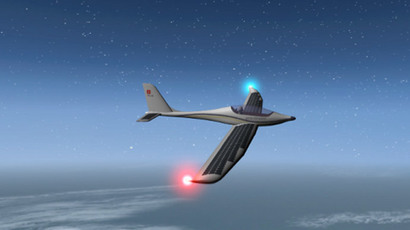Going up and sideways! Germans invent revolutionary elevator (VIDEO)

An elevator every 30 seconds will be a feature of future skyscrapers, promises German tech giant ThyssenKrupp. They have unveiled technology that allows more than one car in a single shaft and the lifts can go sideways as well as up and down.
The company says its invention will revolutionize modern architecture, because central blocks of elevator shafts – a necessary element of today’s buildings, will no longer put constraints on design. Residents will enjoy reduced waiting times and owners will get smaller elevator footprints, freeing up space for apartments, offices and other facilities.
Key to the promised breakthrough is a linear motor, which ThyssenKrupp adapted from the Transrapid magnetic levitation train it built for Shanghai in collaboration with Siemens. Each car would need only one motor for both horizontal and vertical movement, the company said.
The cars will move in a looped path much as cars in a Ferris wheel do, which allows for greater passenger traffic and reduces waiting time to as low as 15 to 30 seconds. But each car will be able to stop independently to allow passengers to enter and exit safely, unlike paternoster lifts, popular in the first half of 20th century. Paternosters actually never stopped and passengers had to hop on and off.
ThyssenKrupp says replacing cable drives with maglev technology and the use of lighter carbon materials for cars would require smaller shafts. Combined with a large number of cabins, it would occupy up to fifty percent less space than current systems, depending on height.
The German company is aiming high with the technology, saying the ideal height for applying it would start at 300 meters. ThyssenKrupp says the option for horizontal movement would make their elevators useful in shorter, broader buildings.
The company hails its technology called Multi as the greatest innovation in the field since Elisha Otis and his demonstration of emergency breaks in 1854. The first building to use a prototype will be a 240-meter tower now being built in Rottweil in Germany. The public will be able to try the system in 2016, the company says.
Multi faces competition from Japanese producer Hitachi, which is currently developing an upgraded version of the old paternoster system. The Hitachi system is a traditional cable-driven elevator, with cars that move up and down in pairs in two adjacent shafts.
The German giant is also working on adopting maglev train motors to other applications. Earlier this year it revealed its speed passenger walkways. Every pallet on it is expandable, has its own motor and moves slower at places where passengers board and leave the walkway, but accelerates to 7 kilometers per hour in between. ThyssenKrupp is targeting walkways in airports and short-range transit system in urban areas.














